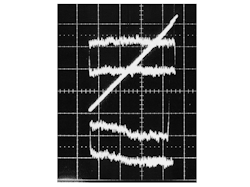This article is in Bob Pease on Analog Vol. 1 in the Analog section of the Electronic Design Library.
Members can download the PDF ebook.
When I present seminars, I often ask the members of the audience to hold up their hands if they think bipolar op amps have better gain and linearity than CMOS. I get a good majority of hands. But neither is bad!
The good-old LM301A (well over 30 years old) has a good gain of 260,000 at no load, with just 75 µV p-p of gain error while its output is swinging 20 V p-p (Fig. 1). What happens when we put on a load? With its rated 2k load, the gain falls and even reverses a little and becomes nonlinear in its error.The lower curve shown here (with a 1k load to exaggerate the error) shows that the LM301A’s nonlinearity becomes as big as 48 µV p-p. This isn’t due to low “gain” or gM, but to thermal feedback from the output transistors to the input transistors, which is caused by imperfect layout of the temp-sensitive input transistors.
Well, this does look lousy, but there are mitigating factors. This thermal effect is most obvious at 0.2 to 20 Hz. At frequencies above 150 Hz, this effect tends to go away and smear out, and at 1 kHz, you can hardly see it. So, this isn’t a big problem for audio amplifiers.
Also, if the amplifier isn’t driving heavy load currents, this thermal problem shrinks proportionately. At light loads, it’s negligible. Even with a 4k load, an LM301 can make a unitygain inverter with a nonlinearity of 1.2 ppm. At lighter loads, it’s even better.
Where can you learn more about this thermal crosstalk? At Application Note AN-A, written by Jim Solomon. If you go to www.national.com/rap and type AN-1485 in the search space, it explains this thermal feedback and also tells you how to find AN-A. So, even bipolar amplifiers with “low” output impedance can have imperfect gain and linearity due to thermal feedback from the output transistors to the input stages.
ON THE BENCHNow let’s look at some CMOS amplifiers with ~ rail-to-rail outputs. The LMC662 is typical—one of our first CMOS amplifiers (Fig. 2). Like the LM301A, its gain degrades when overloaded with 1 kO. But the nonlinearity (deviation from best straight line) is only 18 µV p-p. That’s not bad for an 8-V, 8-mA p-p swing.
This isn’t thermal cross-talk, just a matter of honest gain. The LMC662 has four honest gain stages to source current, but just three stages to sink load current. Still, its high output impedance causes the gain to rise a lot when lightly loaded. How high does it rise? Well, it seems to rise higher than 4 million, but the error is down in the noise. As with the LM301A, its distortion when driving a 4k load is about 1.2 ppm.
So, it really is possible to get low distortion with ordinary op amps. And, it’s easy to get exquisite linearity with good, inexpensive amplifiers. For example, the LMC6022 does better than 0.3 ppm (Fig. 3). That’s pretty good for a micropower op amp. Its open-loop ZOUT is above a megohm, but its closed-loop ZOUT is below a milliohm!
In this app note, I explain the gain curves of dozens of op amps. Be sure to look up the lowvoltage LMC6042 and the full-voltage LME49720, for example. They are better than 0.3 ppm nonlinear! Appendix A on pages 22-23 of that app note lists many op amps, using both CMOS and bipolar transistors, with nonlinearities from 2 ppm down to 0.3 and even 0.03 ppm. All were tested using the gain test circuits shown.
Comments invited!
Read more article from Bob Pease on Analog Vol. 1.
About the Author

Bob Pease
Bob obtained a BSEE from MIT in 1961 and was a staff scientist at National Semiconductor Corp., Santa Clara, CA, for many years. He was a well known and long time contributing editor to Electronic Design.
We also have a number of PDF eBooks by Bob that members can download from the Electronic Design Members Library.



